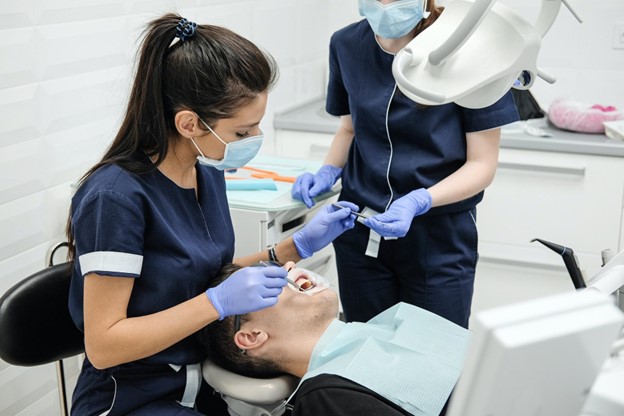Like your bones, teeth are intended to last a lifetime. But a lot can happen as you age, and even the healthiest set of teeth can fall victim to the ravages of time and bad habits.
Healthy teeth play an important role in overall health, but few people can maintain a sparkling smile without regular trips to the dentist. If something bothers you about your smile, the good news is that most common dental complaints are easy to fix. Here are four of the most frequent concerns people have about their teeth—and what to do about them.
1. Stained Teeth
Sometimes your pearly whites are not exactly white. A common dental complaint is stained or discolored teeth. While the most common causes are smoking and drinking habits—coffee, tea, and sodas can stain tooth enamel—some genetic factors can make a person more prone to tooth staining. You can fix stained teeth by:
- Lifestyle changes
- Regular dental cleanings
- A home-based, DIY tooth whitening kit
- Professional teeth whitening at the dentist
Quitting smoking or brushing after drinking coffee will certainly help, as will receiving dental cleanings every six months. According to the American Dental Association, over-the-counter DIY whitening kits take longer to show effects. While it may be more expensive, an in-office whitening treatment from your dentist is the most efficient, longest-lasting solution to staining.

2. Gaps In Teeth
A gap can occur between any adjacent teeth. Gaps can collect food, making it easier for bacteria to grow in your mouth. Many people consider gaps unsightly.
Gaps can be caused by a variety of reasons. Teeth can move apart if one is missing, for example. There may be underlying anatomical reasons that may require surgery to fix. Many gaps, however, are not that serious.
Gaps that don’t require surgery might be fixed in a number of different ways, depending on the underlying cause. All of them will require a trip to your local dentist.
Dental Implants:
An implant is your best choice if you have a missing tooth or a large gap. An implant is an artificial tooth that can be permanently or temporarily implanted by your local dental professional. Many patients are satisfied with this option, but it can be expensive, and some insurance policies won’t cover it.
Dentures:
As a temporary option, dentures can be a suitable choice for many patients. Similar to dental implants, they are used to replace an entire tooth or several teeth. Dentures are usually cheaper than a comparable number of dental implants.
Crown or Veneer:
A crown covers a tooth completely and is big enough to make up the gap. A veneer is similar but covers just the front of the tooth along with the gap. If your tooth gap causes a problem with your bite, a crown may be the cure. For small gaps not on a chewing surface, a veneer may be a more cost-effective solution. Ask your dentist for the best option.
Dental Bonding:
Dental bonding uses a plastic resin that hardens under a specific light. The resin can be applied to build up a tooth or fill a gap. It is a fast and relatively inexpensive procedure that can be used on smaller gaps.
Gap Bands:
The least expensive method of addressing gaps are elastic gap bands. These bands are temporarily applied to adjacent teeth to pull them together. This method is not suitable for every mouth and is limited to closing small gaps only.
3. Chipped and Cracked Teeth
While this often seems less urgent than other dental issues, chipped, cracked, and damaged teeth should be fixed before the damage grows. The treatment plans your dentist might suggest will depend on the damage.
A slightly chipped tooth may often be fixed with dental bonding as discussed above. A crown may be necessary for larger chips.
Cracked teeth are a common dental complaint, especially among patients older than 50. Common reasons for cracks include teeth grinding or even biting something too hard when your tooth has weakened for other reasons.
Since cracks can happen in so many ways, there’s no set treatment. In severe cases the only treatment possible is extraction. Dental bonding and crowns may be used to fix less serious conditions—another reason why it’s important to see your dentist as soon as possible after you discover a crack.
4. Poor Alignment and Crooked Teeth
Poorly aligned or crooked teeth can make chewing difficult. They can make an impact on your smile and sense of confidence. While dental implants and dental veneers offer some ways to treat simple alignment issues, braces may offer a better solution. Braces can be the only treatment option in some cases.
Braces can be metal or ceramic. They are attached to the teeth and apply pressure that gradually corrects the position of the teeth. Braces require a dental professional for fitting and follow-up visits to check progress and make adjustments.
An increasingly popular alternative is the use of removable aligners. They are used to straighten teeth without braces.
Aligners are not braces, but they function the same way by applying light and steady pressure to move teeth. Usually, aligners are made of clear or tooth-colored plastic that slips over the teeth. They are easily removed for eating and cleaning.

The Takeaway? See Your Dentist
It’s common to suffer some damage to your teeth, but no matter what the issue is, it’s advisable to speak to your dentist as soon as possible. There are often multiple ways to address a complaint with your smile, and it’s always cheaper to fix problems early. Not only will you save money, but you will be more likely to feel satisfied with the results.
 Written by: Aaron Smith
Written by: Aaron Smith
Aaron Smith is an LA-based content strategist and consultant in support of STEM firms and medical practices. He covers industry developments and helps companies connect with clients. In his free time, Aaron enjoys swimming, swing dancing, and sci-fi novels.









